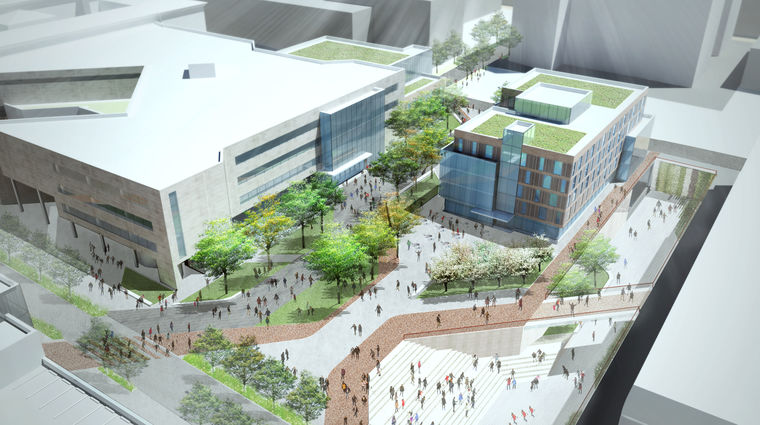Muhlenberg College Campus Master Plan
campus planning, architecture, landscape architectureMuhlenberg College is one of the premier liberal arts institutions in the nation. In 2017, the College adopted a Strategic Plan that outlined key actions to strengthen the value of Muhlenberg’s liberal arts education and the distinctiveness of their Allentown, PA campus to attract, support, and retain new students. At the heart of the Strategic Plan was a desire to reinvent campus spaces and facilities so that students feel more connected—to the facilities they use daily, to each other, and to the Muhlenberg community at large.


WRT’s Campus Master Plan sought primarily to reinforce the differentiator that the College calls the “Muhlenberg Education”—the union of pre-professional, science, and humanities programs in their four-year degree. As with all our campus master planning projects, WRT connected with the campus community through extensive engagement efforts.
Remarkably, this was the College’s first Campus Master Plan, and the engagement process elicited heightened and illuminating dialogue on issues of place-making, academic vision, residential life, and the significant results that can come from seemingly small changes. Our findings from the engagement sessions shaped our recommendations, as did review of facility assessments, infrastructure condition reports, landscape design guidelines, and residential life and parking policies.
With Muhlenberg’s Strategic Plan as a framework, the Campus Master Plan focused on three key components: 1) Engaging liberal arts learning; 2) Enhancing the campus community; and 3) Reinventing residential life at Muhlenberg. It sought to integrate existing structures, replace outdated spaces, and create inviting, connected, and inspirational learning environments in tune with the College’s goals. If the campus can reflect, support, and enhance Muhlenberg’s pre-professional / liberal arts approach, then the Muhlenberg education will achieve its competitive edge.


Our Campus Master Plan integrated two distinct parts of campus, carefully preserving the original campus layout organized around the College Green and expanding it to provide a flexible development framework. We recommended replacing existing surface parking spaces with programmed open spaces and new buildings at the north and south ends of the campus to expand and unify the academic core and infill the new buildings sensitively.

To reinforce the unity of buildings and ample outdoor public spaces, the Plan recommended three new walkway loops and four east-west pedestrian paths. Additionally, it created two new outdoor places—the Alumni/Student Green on a former parking lot, and the Library Commons, connecting south campus with the academic core.
Two new academic buildings—the Center for Student Engagement and the Integrative Academic Building—reinforced the interdisciplinary curriculum, while the expansion and renovation of Trexler Library added collaborative learning spaces. The Plan recommended more active uses along West Chew Street and reinvigorating dead spaces, such as the walkway between the Library and the Baker Center for the Arts, by creating a new 1,000-seat capacity theater that takes advantage of campus topography and views.
Because many Muhlenberg students currently live off-campus, the Plan proposed two new residence halls to bring them home, contributing to the campus vitality that every prospective freshman wants to see and feel. The new dormitories anchored outdoor spaces and included ground-level retail.



The campus planning process helped to determine both a long-range vision and short-term priorities and projects for implementation. All recommendations were carefully evaluated for fundraising potential, impact on achieving the Strategic Plan objectives, and ability to meet urgent academic and residential needs. Ultimately, our recommendations, including the phased approach to implementation, helped galvanize support from the Muhlenberg campus community, senior leadership, and the Board of Trustees. Muhlenberg hopes that the Plan will serve as a model for other institutions striving to improve their campuses by creating more integrated living and learning environments—and WRT is eager to witness the next stage in Muhlenberg’s evolution.
Related Projects
A collection of contextually diverse campus landscapes and learning spaces, integrating the built and natural environments.


